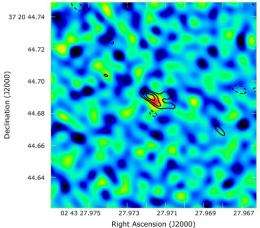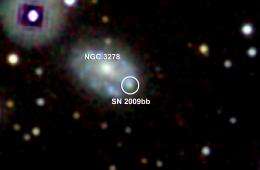Newborn Black Holes May Add Power to Many Exploding Stars

(PhysOrg.com) -- Astronomers studying two exploding stars, or supernovae, have found evidence the blasts received an extra boost from newborn black holes. The supernovae were found to emit jets of particles traveling at more than half the speed of light.
Previously, the only catastrophic events known to produce such high-speed jets were gamma-ray bursts, the universe's most luminous explosions. Supernovae and the most common type of gamma-ray bursts occur when massive stars run out of nuclear fuel and collapse. A neutron star or black hole forms at the star's core, triggering a massive explosion that destroys the rest of the star.
"The explosion dynamics in typical supernovae limit the speed of the expanding matter to about three percent the speed of light," explained Chryssa Kouveliotou, an astrophysicst at NASA's Marshall Space Flight Center in Huntsville, Ala., co-author of one of the new studies. "Yet, in these new objects, we're tracking gas moving some 20 times faster than this."
The new results, published in this week's edition of the journal Nature, used observations from several space and ground-based observatories, including NASA's SWIFT satellite.
The astronomers discovered the ultrafast debris by studying two supernovae at radio wavelengths using numerous facilities, including the National Science Foundation's Very Large Array in Socorro, N.M., and the Robert C. Byrd Green Bank Telescope in West Virginia. One team used the real-time operating mode of the European Very Long Baseline Interferometry Network, an international collaboration of radio telescopes, to rapidly analyze data.

"In every respect, these objects look like gamma-ray bursts -- except that they produced no gamma rays," said Alicia Soderberg at the Harvard-Smithsonian Center for Astrophysics in Cambridge, Mass.
Soderberg led a team that studied SN 2009bb, a supernova discovered in March 2009. It exploded in the spiral galaxy NGC 3278, located about 130 million light-years away.
The other object is SN 2007gr, which was first detected in August 2007 in the spiral galaxy NGC 1058, some 35 million light-years away. The study team, which included Kouveliotou and Alexander van der Horst, a NASA Postdoctoral Program Fellow in Huntsville, was led by Zsolt Paragi at the Netherlands-based Joint Institute for Very Long Baseline Interferometry in Europe.
The researchers searched for gamma-ray signals associated with the supernovae using archived records in the Gamma-Ray Burst Coordination Network located at NASA's Goddard Space Flight Center in Greenbelt, Md. The project distributes and archives observations of gamma-ray bursts by NASA's Swift spacecraft, the Fermi Gamma-ray Space Telescope and many others. However, no bursts coincided with the supernovae.
Unlike typical core-collapse supernovae, the stars that produce gamma-ray bursts possess what astronomers call a "central engine" -- likely a nascent black hole -- that drives particle jets clocked at more than 99 percent the speed of light.
By contrast, the fastest outflows detected from SN 2009bb reached 85 percent the speed of light and SN 2007gr reached more than 60 percent of light speed.
"These observations are the first to show some supernovae are powered by a central engine," Soderberg said. "These new radio techniques now give us a way to find explosions that resemble gamma-ray bursts without relying on detections from gamma-ray satellites."
Perhaps as few as one out of every 10,000 supernovae produce gamma rays that we detect as a gamma-ray burst. In some cases, the star's jets may not be angled in a way to produce a detectable burst. In others, the energy of the jets may not be enough to allow them to overcome the overlying bulk of the star.
"We've now found evidence for the unsung crowd of supernovae -- those with relatively dim and mildly relativistic jets that only can be detected nearby," Kouveliotou said. "These likely represent most of the population."
Provided by JPL/NASA


















